Don't wanna be here? Send us removal request.
Text

The Polo Shirt’s Chic Revival: How This Preppy Classic Became 2025’s Must-Have Wardrobe Staple
The polo shirt—a piece once synonymous with preppy sportswear and casual uniformity—is undergoing a bold renaissance in 2025. Once confined to tennis courts, country clubs, and school uniforms, this timeless essential has been reimagined with a contemporary, feminine edge. Cropped silhouettes, exaggerated collars, delicate embroidery, and unexpected fabrics have transformed it from a predictable staple into a statement piece.
Now embraced by designers, influencers, and fashion enthusiasts alike, the polo shirt has evolved beyond its athletic roots, proving its versatility across workwear, off-duty dressing, and even evening wear. With a newfound ability to blend structure with ease, it’s redefining smart-casual dressing for a new generation.
But how did this sportswear classic go from a symbol of prep-school formality to fashion’s most coveted staple?
A Brief History: From the Tennis Court to the Runway
The polo shirt’s origins date back to the 1920s when French tennis legend René Lacoste sought an alternative to the stiff, long-sleeved shirts worn on the court. His innovative design—a soft-collared, short-sleeved cotton shirt with a buttoned placket—offered both functionality and style, marking the birth of what would become a sportswear classic. Lacoste’s creation revolutionised tennis attire, replacing outdated dress codes with a piece that balanced performance and polish.

By the mid-20th century, the polo shirt had transcended its athletic beginnings. It became a staple of Ivy League preppy style in America, a symbol of effortless sophistication when paired with chinos or layered under a blazer. In Britain, it was adopted by the mod subculture, worn buttoned-up for a sharper, rebellious edge. Throughout the decades, everyone from rockstars to royalty embraced the polo’s clean-cut aesthetic, securing its place in the fashion lexicon.
However, despite its enduring appeal, the polo shirt was often seen as more functional than fashionable—until now.
The 2025 Polo Shirt: Reinvention & Relevance
Fast forward to 2025, and the polo shirt has undergone a radical transformation. No longer just a reliable go-to for sportswear enthusiasts or preppy dressers, it has emerged as a symbol of contemporary chic.
Designers have taken the polo beyond its traditional cotton piqué construction, experimenting with elevated materials like ribbed knits, silk blends, and fine cashmere. The classic collared silhouette has been reinterpreted with asymmetric cuts, statement sleeves, and contrast stitching, adding a fresh, directional feel.
Fashion houses are embracing the polo shirt’s revival with open arms. Brands like Miu Miu, Prada, and Jacquemus are introducing cropped polos with bold piping and embroidered details, while heritage labels such as Ralph Lauren and Lacoste are refining the classic design with modern tailoring and a more luxurious feel. Even high-street brands are tapping into the trend, offering fitted, ruched, and oversized variations to cater to a new generation of wearers.
But what makes the polo’s resurgence particularly exciting is its adaptability. In a fashion landscape that demands both comfort and sophistication, the polo seamlessly bridges the gap between laid-back and polished.
Why the Polo Shirt Works in 2025
The resurgence of the polo shirt is emblematic of a broader shift in fashion—one that prioritises balance. As we transition out of the ultra-casual loungewear era that dominated the early 2020s, there is a growing demand for pieces that feel refined yet effortless. Consumers no longer want to choose between comfort and polish; they want both.
The polo meets this need perfectly, offering a structured yet relaxed silhouette that can be styled in countless ways. It’s inherently timeless, yet its modern iterations feel fresh and relevant. The key to its staying power lies in its ability to adapt—whether through a bold new cut, an unexpected fabric, or a subtle styling tweak.

This is why the polo shirt isn’t just another fleeting trend. While micro-trends may come and go, the polo remains a wardrobe constant—one that evolves with the times while retaining its classic appeal.
How to Style the Feminine Polo Shirt
One of the defining qualities of the polo shirt is its versatility. Whether styled for a sleek, minimalist look or given a playful, modern twist, it effortlessly adapts to a variety of aesthetics.
1. Sleek & Minimalist:
A fitted knit polo tucked into high-waisted tailored trousers, paired with sleek loafers or pointed-toe mules, creates a refined, modern look. Keep accessories simple—gold hoops, a structured handbag, and a slicked-back bun will elevate the ensemble.
2. Casual & Cool:
For a relaxed yet contemporary feel, pair a cropped polo with wide-leg denim and chunky trainers. Add a baseball cap and a crossbody bag for an effortlessly cool, off-duty vibe.
3. Work-Ready Elegance:
Opt for a ribbed, long-sleeved polo in a neutral hue, tucked into a pleated midi skirt or high-waisted trousers. Complete the look with a classic trench coat and leather ankle boots for a polished take on office dressing.
4. Evening Glam:
Elevate the polo for after-dark dressing by choosing one in silk or satin. Style it with a flowing midi skirt, statement heels, and layered jewellery for an unexpected yet sophisticated outfit that challenges traditional eveningwear norms.
The beauty of the polo shirt’s revival is its ability to complement any wardrobe—whether your style leans towards effortless minimalism, preppy chic, or modern edge.
Beyond the Trend: The Polo Shirt as a Modern Classic
While its recent reinvention has put it back in the spotlight, the polo shirt’s appeal extends far beyond its current fashion moment. It represents the perfect marriage of past and present, blending heritage design with contemporary styling.
The polo shirt is proof that true classics never fade—they evolve. Just as blazers have been reimagined in oversized silhouettes and tailored shorts have become power dressing essentials, the polo is the latest staple to be redefined for the modern wardrobe.
Its resurgence isn’t just about aesthetics—it’s about versatility, adaptability, and the enduring appeal of effortless style. Whether worn with sleek tailoring or styled for off-duty ease, the polo shirt remains one of fashion’s most enduring icons.
So, if there’s one item worth investing in this year, let it be the polo shirt—because some classics don’t just stand the test of time; they get better with it.
Final Thoughts: A Timeless Essential Reborn
The polo shirt’s 2025 revival proves that even the most established wardrobe staples can be reinvented for the contemporary fashion landscape. Whether structured and sleek or playful and cropped, this essential has secured its place as one of the year’s most exciting must-haves.
With its ability to seamlessly balance casual ease with polished refinement, the polo is more than just a trend—it’s a testament to fashion’s power of reinvention.
This year, the polo shirt isn’t just making a comeback—it’s making a statement.
0 notes
Text

The Second-Hand Shopping Boom – Is Thrifting the New Luxury?
Once a countercultural act of rebellion against mass consumerism, thrifting has transcended its humble roots. No longer confined to musty charity shops and weekend flea markets, second-hand fashion has become a status symbol. What was once about affordability and necessity has morphed into a movement driven by aesthetics, exclusivity, and a conscious rejection of fast fashion.
In an era of Depop-driven microtrends, curated vintage storefronts, and luxury resale platforms, second-hand shopping is no longer a subculture—it’s fashion’s new frontier.
But with its rise comes a paradox: the very industry that positioned itself as an accessible and sustainable alternative is now falling into the same cycles of exclusivity, gentrification, and price inflation as the mainstream fashion world. The question is, has thrifting truly remained an antidote to fast fashion, or has it become another luxury playground?
Second-Hand Fashion: From Fringe to Front-Row
Once dismissed as a niche practice embraced by budget-conscious shoppers and eclectic dressers, second-hand fashion has cemented itself as a dominant force in the industry. By 2025, the global resale market is set to double, growing at a rate far outpacing fast fashion. But this surge in popularity didn’t happen overnight.
Historically, second-hand fashion was associated with necessity rather than choice. In the early 20th century, wearing pre-owned clothing often carried social stigma—reserved for those who couldn't afford new garments. But over time, vintage fashion became synonymous with individuality and cultural rebellion. Think of the bohemian thrifters of the 1970s, the grunge-fueled thrift store aesthetic of the ’90s, or the Y2K resurgence that has turned forgotten 2000s clubwear into collector’s items.
Today, second-hand fashion represents more than just nostalgia—it signals a shift in values.
Sustainability Is No Longer a Trend—It’s a Mandate. As the environmental consequences of fast fashion become impossible to ignore, consumers are actively seeking more ethical alternatives. Thrifting presents itself as the most sustainable way to shop—reducing waste, extending garment lifecycles, and promoting conscious consumption.
Affordability—At Least, It Used to Be. Vintage shopping once meant high-quality craftsmanship at a fraction of the price. Now, with demand at an all-time high, thrift store finds often carry luxury-level price tags.
The End of Mass Trends, The Rise of Personal Style. Second-hand fashion allows wearers to break free from the homogeneity of fast fashion. Instead of buying into seasonal trends dictated by retailers, shoppers curate wardrobes that are uniquely their own.
Social Media & The Aesthetic Economy. Platforms like Instagram and TikTok have transformed second-hand shopping into a status game. Authenticity, rarity, and nostalgia are the new luxury.
Fashion as an Asset Class. The rise of luxury resale has reframed pre-owned designer pieces as investments rather than afterthoughts, blurring the line between style and financial strategy.
But as thrifting moves from necessity to aesthetic flex, the industry is shifting in ways that threaten its accessibility.
The Billion-Dollar Resale Boom: When Thrifting Becomes Big Business
The days of rifling through bargain bins and unearthing hidden gems are being replaced by an ultra-curated, algorithm-driven shopping experience. Platforms like Depop, Vestiaire Collective, and The RealReal have commercialized second-hand fashion on a massive scale, each catering to different segments of the market.
Depop turned thrifting into an influencer-driven economy, where styling and storytelling are just as important as the clothes themselves.
Vestiaire Collective elevated resale, making it a premium experience for fashion insiders and collectors.
The RealReal brought authentication and curation to pre-owned luxury, normalizing second-hand designer goods in the mainstream market.
What was once a grassroots, community-driven movement has become a billion-dollar industry. And with that transformation, a critical issue emerges: the more lucrative resale becomes, the less accessible it gets.
The Gentrification of Thrifting: When Second-Hand Stops Being Affordable
Here’s the irony—what started as an affordable alternative to fast fashion is now edging out the very consumers who relied on it.
Thrift store prices are skyrocketing. That £5 charity shop find? It’s now £50 on Depop.
Resellers are clearing out inventory. Low-income shoppers who once depended on thrift stores for affordable clothing now face dwindling options as resellers flip items for profit.
Luxury fashion is gatekeeping resale. Brands like Burberry and Gucci are launching in-house resale platforms to control the second-hand economy—while continuing to mass-produce new collections.
Sustainability and accessibility were once the pillars of second-hand fashion. But can the industry still claim to be truly sustainable if the price of entry is becoming increasingly unattainable?
The Future of Second-Hand Fashion: What Happens Next?
As resale cements itself as the future of fashion, the industry faces two possible paths: will it remain an accessible, sustainable alternative, or will it morph into another luxury commodity?
High-Street Goes Circular. Brands like H&M, Levi’s, and COS are introducing resale and buy-back programs to keep up with demand for pre-owned fashion.
Luxury Brands Control Their Own Resale. With in-house resale platforms, high-end labels are monetizing their own second-hand markets while reinforcing exclusivity.
The Digital Evolution: NFTs & Virtual Fashion. As digital fashion and blockchain authentication rise, second-hand fashion could soon extend beyond physical garments.
But is mainstream adoption a good thing? If big brands take over, will thrifting remain about sustainability, or will it become just another chapter in fashion’s exclusivity playbook?
Final Thoughts: The Paradox of Pre-Loved Luxury
Once a quiet rebellion against mass production, thrifting has become a cultural phenomenon—a billion-dollar industry driven by hype, scarcity, and status.
The irony? The very movement meant to challenge the excess of the fashion industry is now mirroring its patterns of exclusivity.
The future of second-hand fashion depends on whether it can retain its original ethos or succumb to the forces of commercialization. One thing’s for sure: the resale boom isn’t slowing down anytime soon.
0 notes
Text

The Museum of the Future: How Immersive Tech is Changing Art Spaces
Museums have long been places of quiet reflection, where viewers engage with art by observing from a respectful distance. But in recent years, immersive technology has begun to revolutionise these spaces, turning passive viewing into interactive, multi-sensory experiences. From augmented reality (AR) to virtual reality (VR), technology is reshaping how we connect with art and history.
This shift raises exciting questions: are we enhancing cultural experiences or losing something in the process? And what does the Museum of the Future look like?
The Rise of Immersive Technology in Museums

Immersive technology is redefining traditional museums, offering audiences the chance to step inside art and history. Exhibits like Van Gogh Alive, where visitors are surrounded by animated projections of the artist's work, and the Frameless Immersive Art Experience in London, which brings iconic paintings to life, are just the beginning. These experiences go beyond observation, encouraging viewers to engage physically and emotionally.
Interactive exhibits are also breaking down barriers, making art more accessible to younger, tech-savvy audiences. Features like AR overlays in historical museums allow visitors to visualise ancient ruins as they once were, while VR tours of archaeological sites transport viewers to far-off locations.
The Debate: Enhancing or Distracting?
While immersive technology is undoubtedly captivating, it also has its critics. Some argue that the spectacle of these exhibits overshadows the art itself, shifting focus from the artist’s intention to the technology. For example, the contemplative atmosphere of the Rothko Room at the Tate Modern relies on the stillness of the space—a quality that could be lost in an immersive reinterpretation.
Another concern is the environmental cost. Immersive installations often require significant energy to operate, raising questions about sustainability in a world increasingly focused on reducing waste and emissions.

London has become a leader in integrating technology into its art spaces. The Saatchi Gallery and Southbank Centre regularly host cutting-edge exhibits, while smaller venues like Frameless in Marble Arch are experimenting with boundary-pushing concepts. These institutions are turning the city into a global hub for immersive art, blending tradition with innovation.
The Future of Museums
The museum of the future is likely to be a hybrid—a space where traditional exhibits coexist with immersive installations. As technology continues to evolve, museums will have new opportunities to reach broader audiences, offer more inclusive experiences, and engage visitors in ways that weren’t possible before.
Imagine a world where AI curates personalised tours based on your preferences or AR glasses enhance exhibits by overlaying historical information in real time. The possibilities are endless, but the challenge will be ensuring that technology serves the art, rather than overshadowing it.
Immersive technology is reshaping the way we experience art, challenging the boundaries of what museums can be. While it presents new opportunities for engagement and accessibility, it also raises critical questions about sustainability and authenticity.
As we look ahead, the future of museums will depend on their ability to balance innovation with tradition, ensuring that the magic of the art itself remains at the heart of the experience.
0 notes
Text

The AI Revolution in Fashion: Creativity or Chaos?
Artificial intelligence has infiltrated the fashion industry with an intensity that is impossible to ignore. No longer confined to the back-end realms of predictive analytics and supply chain logistics, AI is now actively shaping fashion’s creative landscape—designing garments, curating digital wardrobes, and even forecasting trends before they emerge.
For some, this is a thrilling evolution. AI streamlines production, reduces waste, and enhances creativity by offering designers new tools to push the boundaries of innovation. For others, it is deeply unsettling—a digital force that risks flattening the artistry of fashion, reducing originality to algorithmic predictions and data-driven formulas.
As the industry navigates this new digital frontier, one thing is clear: AI is not a fleeting trend. It is a transformative force redefining the way fashion is created, consumed, and experienced. But will it elevate the industry, or strip it of its essence?
How AI is Reshaping Fashion
AI’s influence is spreading across every sector of fashion—from design and manufacturing to retail and consumer engagement. Once considered experimental, AI is now fully embedded in the industry’s DNA.
AI-Driven Personalisation: The New Retail Revolution
Gone are the days of generic shopping experiences. AI-powered platforms like The Yes and Stitch Fix have set new standards for hyper-personalised fashion, using complex algorithms to analyse customer behaviour and predict individual style preferences. Luxury brands are also embracing AI, with Farfetch and Net-a-Porter refining their recommendation engines to create a more tailored shopping journey.
Fast fashion giants like H&M and Zara leverage AI to anticipate upcoming trends and optimise stock levels, minimising overproduction and reducing waste—one of the industry’s biggest sustainability challenges. In theory, AI is making fashion more efficient and less wasteful. But is it also making it less inspired?
AI as a Creative Partner: Tool or Threat?
One of the most radical shifts is AI’s role in the creative process itself. Generative AI tools like OpenAI’s DALL·E and DeepDream allow designers to explore endless iterations of prints, textures, and silhouettes within seconds. Some brands are already using AI to conceptualise entire collections, experimenting with machine-generated aesthetics that challenge traditional notions of craftsmanship.
Pioneers of digital fashion, such as The Fabricant and DressX, are harnessing AI to create virtual garments that exist solely in the digital realm—designed for metaverse avatars and NFT collectors. Meanwhile, luxury houses like Gucci and Balenciaga are experimenting with AI-generated design concepts, blending technology with high fashion in ways that blur the line between human and machine creativity.
But herein lies the debate: Is AI acting as a co-pilot for designers, enhancing their vision? Or is it simply recycling past successes into formulaic trends, stifling true innovation?
AI’s Role in Sustainable Fashion
One of AI’s most promising contributions is its ability to drive sustainability. By refining material use, predicting demand with greater accuracy, and optimising supply chains, AI has the potential to reduce fashion’s environmental footprint significantly.
Brands like PANGAIA are already using AI to develop innovative bio-materials, such as lab-grown fibres and plant-based dyes. Meanwhile, denim giant Levi’s employs AI to refine water-saving production techniques, cutting waste without sacrificing quality.
However, sustainability is not just about efficiency—it is about ethical decision-making. While AI can make production more sustainable, it can also be exploited for cost-cutting strategies that prioritise profits over ethical labour practices. The challenge lies in ensuring AI is used for environmental progress rather than corporate convenience.
The Risks of Homogenisation: Will AI Make Fashion Boring?
For all its advantages, AI also poses a significant risk: the homogenisation of fashion. By relying on data-driven trend forecasting, AI reinforces existing patterns rather than encouraging radical reinvention.
Fashion has always been about unpredictability—moments of creative rebellion that redefine entire eras. From punk’s DIY aesthetic to ’90s grunge, these movements emerged from raw artistic instincts, not algorithmic analysis. If major retailers optimise their collections based on the same AI-driven insights, are we at risk of fashion becoming predictable, formulaic, and devoid of surprise?
Moreover, there is a deeper philosophical question: Can AI truly create, or does it merely remix? While AI can generate thousands of variations of a garment, it lacks the human instinct to take risks, break conventions, or embed deeper cultural narratives into its designs.
Fashion is not just about clothing—it is about identity, emotion, and storytelling. Can an algorithm truly understand the nuances of self-expression?
The Future of AI in Fashion: Collaboration Over Domination
Despite the challenges, AI’s future in fashion does not have to be dystopian. The most exciting potential lies in how it can enhance human creativity rather than replace it. The fashion industry’s future may not be AI versus designers but AI with designers.
AI as a Creative Co-Pilot
Imagine designers using AI as a brainstorming partner—inputting abstract concepts and receiving unexpected visual interpretations in return. AI could also revolutionise prototyping, allowing brands to experiment with sustainable materials at a fraction of the cost and environmental impact.
The brands that will thrive in this AI-powered era will likely be those that blend human intuition with machine-driven insights rather than relying solely on one or the other.
Revolutionising the Consumer Experience
For consumers, AI has the potential to redefine shopping entirely. Virtual try-ons, AI-curated personal styling, and predictive wardrobe recommendations could make the retail experience more seamless than ever. Imagine receiving a seasonal wardrobe update tailored to your existing pieces, lifestyle, and ethical values—all generated by AI.
The question is: will these advancements encourage more mindful consumption, or simply accelerate the fast-fashion cycle by making impulse purchases even easier?
The Ethical Dilemma: Who Owns AI-Generated Fashion?
As AI continues to generate designs, the industry faces a new legal and ethical conundrum: Who owns AI-created fashion? Is it the designer who provided the initial input? The brand funding the technology? Or the AI itself?
Intellectual property laws are still catching up with this reality, and without clear regulations, there is a risk that human creativity will be undervalued in favour of algorithmic outputs. The fashion industry must address these questions before AI-designed clothing becomes the norm.
The Verdict: Opportunity or Threat?
AI represents both an opportunity and a challenge for fashion. When used responsibly, it can drive sustainability, enhance creativity, and personalise the shopping experience. However, if left unchecked, it risks turning fashion into a cycle of algorithm-driven repetition rather than innovation.
Ultimately, AI in fashion should serve as a tool for amplifying human artistry—not replacing it. The industry must strike a balance, ensuring that technology enhances the creative process rather than stripping it of its soul.
The future of fashion should not be dictated by data alone—it should be a harmonious fusion of innovation, imagination, and the irreplaceable human touch.
0 notes
Text
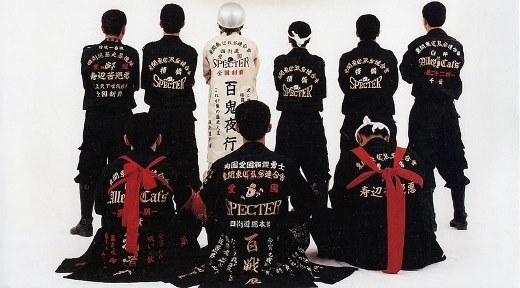
Has Personal Style Been Hijacked by the Algorithm?
In an era where TikTok dictates trends, Instagram outfits blur into uniformity, and Pinterest mood boards recycle the same aesthetics, individuality seems to be slipping away. Once the ultimate form of self-expression, personal style now feels like a casualty of the algorithm—flattened, filtered, and repackaged for mass appeal.
Scroll through social media and you’ll see it: the same oversized blazers, the same Bottega Veneta Andiamo bags, the same clean girl aesthetic. Minimalist gold hoops, sleek bun, neutral tailoring—rinse and repeat. It’s a formula that looks effortless but is, in reality, carefully constructed to perform well in engagement metrics.
So, has personal style truly disappeared, or has it simply evolved into something new?
The Algorithm: Curator or Conformist?
Social media was meant to democratise fashion, liberating style from the grip of traditional gatekeepers like glossy magazines and runway shows. In theory, platforms like Instagram, TikTok, and Pinterest should allow for endless diversity in fashion. In reality, they’ve become engines of repetition, where algorithms prioritise what’s familiar and trending rather than what’s unique.
Take TikTok’s For You Page. It gives the illusion of personalisation, but in reality, it functions as a mirror of collective consumption. The algorithm isn’t asking, What makes you unique? It’s asking, What’s popular right now?
Fashion’s most coveted pieces are no longer dictated by avant-garde designers or cultural movements but by viral trends. A pair of Miu Miu ballet flats, a Loewe tank top, or the whisper of quiet luxury in the form of a perfectly tailored cashmere coat—if it trends, it sells. Social media no longer just reflects fashion; it dictates it. And in doing so, it narrows the scope of style, funnelling millions into the same aesthetic echo chamber.
Fast Fashion and the Death of Distinction
If social media serves as fashion’s new tastemaker, fast fashion is its most loyal disciple. Brands like Zara, Shein, and H&M have mastered the art of speed, translating viral trends into mass-produced garments in a matter of weeks. What once took months—design, production, runway showcases—now takes days.
The result? A flood of near-identical pieces saturating wardrobes worldwide. The same TikTok-approved sweater. The same pleated skirts. The same puffed-sleeve dresses. Clothes, once a canvas for self-expression, have become disposable props in an algorithm-driven aesthetic.
And when the next viral piece emerges? The previous one is abandoned, feeding fashion’s already staggering waste crisis. The environmental toll is immense: landfills filled with last month’s must-haves, microplastics shedding from synthetic fabrics, carbon emissions from an industry that thrives on overproduction.
Fashion has always been cyclical, but never has it been this disposable. In a world where yesterday’s must-have is today’s charity shop donation, how can originality thrive?
A Glimmer of Hope: The Return to Authenticity
Yet, amidst this sea of sameness, a counter-movement is emerging. Second-hand fashion is having a renaissance, with platforms like Depop, Vinted, and Vestiaire Collective offering an escape from mass-produced trends. Vintage shopping has evolved beyond nostalgia—it’s now a rebellion against disposable fashion. A ’90s Jean Paul Gaultier mesh top, a Y2K Dior saddle bag, a one-of-a-kind handmade knit—these are the new status symbols, rich with history and individuality.
Independent designers are also breaking away from trend cycles, crafting collections that prioritise artistry, heritage, and storytelling over fleeting aesthetics. Brands like Bode, Chopova Lowena, and Wales Bonner reject mass replication, embracing craftsmanship and unique design narratives. Their pieces aren’t dictated by viral moments but by a deeper connection to cultural and historical references.
Technology, too, may hold the key to reviving individuality. AI-powered personal styling tools, custom digital wardrobe apps, and platforms for bespoke, made-to-order garments could help redefine how we interact with fashion. Imagine an algorithm that doesn’t push trends but instead curates style based on your personality, preferences, and history—a digital tailor, rather than a trend-chasing machine.
Is Personal Style Dead? Not Quite.
While social media and fast fashion have made originality harder to cultivate, the hunger for self-expression remains. The key to reclaiming personal style lies in resisting the pull of sameness—choosing garments that feel authentic rather than algorithm-approved, embracing pieces that tell a story rather than simply following a trend.
Fashion has always been a delicate balance between conformity and rebellion. History tells us that style movements are often born from a rejection of the mainstream—from the punk movement’s defiant DIY ethos to the anti-fashion minimalism of the 1990s. And if there’s one thing we know for sure, it’s that true style can never be dictated by an algorithm.
Personal style isn’t dead. It’s just waiting for its renaissance.
0 notes
Text

The Rise of -Core Aesthetics: Fashion or Algorithmic Fantasy?
From cottagecore’s whimsical pastoralism to blokecore’s nostalgic terrace culture, the rise of "-core" aesthetics has redefined the way we engage with fashion. In an age where digital spaces dictate trends as much as runways do, these hyper-niche movements are no longer just about clothing—they are immersive worlds, each imbued with a distinct mood, lifestyle, and identity.
Yet, as these aesthetics flood our feeds at an ever-accelerating pace, one question lingers: are they a true celebration of individuality, or are they merely another byproduct of an algorithm-driven culture, designed to package, market, and sell self-expression?
What Exactly Is a "-Core"?
A "-core" is more than just a fashion trend—it is an aesthetic manifesto, a visual shorthand for a specific lifestyle and ideology. It isn’t just about what you wear; it’s about the world it invites you into.
Take cottagecore, for example. Romanticising rural life, it evokes a vision of soft, flowing dresses, delicate florals, and hand-knit jumpers, all bathed in the golden glow of a sunlit meadow. But beyond fashion, it reflects a yearning for simplicity, an escape from the frenetic pace of modern life in favour of slow living, home baking, and handwritten letters. It reached peak popularity during the COVID-19 lockdowns, when the outside world felt chaotic, and retreating into a pastoral fantasy provided solace.
By contrast, blokecore channels an entirely different kind of nostalgia—one rooted in the raw, unpolished aesthetic of ’90s football culture. Think retro jerseys, baggy jeans, and well-worn Adidas trainers. It thrives on effortless authenticity—or at least, the illusion of it—celebrating the no-fuss, pint-before-the-match aesthetic of the pre-digital age.

Then there’s weirdcore, an eerie, pixelated distortion of reality that thrives on dreamlike nostalgia and surreal imagery. Less fashion-centric than its counterparts, weirdcore taps into collective memory, drawing on the unsettling aesthetics of early internet culture, low-resolution graphics, and liminal spaces.
At their heart (no pun intended), these aesthetics serve as forms of escapism. Whether you’re drawn to the soft-focus dreamscape of cottagecore, the lad-casual aesthetic of blokecore, or the uncanny nostalgia of weirdcore, each "-core" offers a way to shape identity through fashion and aesthetics. But how much of this identity is organic—and how much is being dictated by the digital ecosystem we exist in?
The Algorithm: Curator or Conformist?
Though "-core" aesthetics often feel like intimate expressions of selfhood, their rise has been anything but organic. Social media platforms such as TikTok, Instagram, and Pinterest act as trend accelerators, transforming niche subcultures into viral movements overnight. Algorithms detect engagement spikes and push content to wider audiences, ensuring that even the most obscure aesthetics are swiftly catapulted into mainstream consciousness.
Take goblincore, for example—a once-fringe aesthetic rooted in earth tones, foraging, and an embrace of imperfection. Initially a quiet rejection of conventional beauty ideals, it was quickly swept into the mainstream, its raw authenticity repackaged for mass consumption. Soon, high-street brands were churning out mushroom-printed dresses and moss-green cardigans, diluting its original ethos.
This is the paradox of algorithm-driven fashion: the same platforms that amplify these aesthetics also erode their subcultural meaning. Cottagecore may have begun as a slow-fashion movement, but it wasn’t long before fast-fashion retailers capitalised on its aesthetic appeal, mass-producing ruffled dresses and faux-handmade knitwear. Blokecore, similarly, is already being absorbed by high-street brands eager to commodify its grassroots origins.
And then there’s the issue of longevity. TikTok trends rarely last more than a few weeks before being discarded in favour of the next viral aesthetic. As a result, movements that once symbolised countercultural resistance are now reduced to fleeting micro-trends, repackaged and resold before they’ve had time to establish themselves authentically.
So, if personal aesthetics are being dictated by algorithms, are they truly ours? Or are we simply dressing according to what the For You Page serves us?
The Future of -Core Fashion
Despite the rapid commodification of "-core" aesthetics, their rise signals a fascinating shift in how we engage with fashion. As technology advances, we may see even more hyper-personalised style movements emerge. Imagine AI-powered fashion tools that allow individuals to blend elements of cottagecore, blokecore, and other aesthetics to create entirely unique looks. Or virtual wardrobe apps that let users experiment with aesthetics in a digital realm before committing to them in real life.
The rise of the metaverse and digital fashion further complicates the landscape. With the increasing popularity of virtual clothing, avatar personalisation, and NFT fashion, will aesthetic movements continue to shape physical fashion, or will digital wardrobes birth entirely new, algorithm-native aesthetics untethered from traditional materials?

Beyond technology, these movements also raise broader questions about the sustainability of trend culture. As concerns over waste and overproduction mount, will fashion’s obsession with micro-trends give way to a renewed appreciation for longevity? Will future "-core" aesthetics prioritise depth over aesthetics alone?
To remain relevant, these aesthetics may need to evolve beyond surface-level styling, reconnecting with the deeper cultural and ideological roots that first gave them meaning.
Trend or True Identity?
“-Core” aesthetics are more than just fashion trends—they are reflections of a fragmented, hyper-specific cultural landscape where identity is often curated as much as it is lived. These movements offer a form of storytelling, a way of shaping how we present ourselves to the world.
Yet, in an era where trends are dictated by algorithms and brands rapidly commercialise aesthetics, the challenge is to engage with these movements meaningfully. Cottagecore should be more than just a pretty dress—it should represent a shift towards intentional living, however small. Blokecore should be more than a retro football shirt—it should carry a personal connection to the culture it references.
At its best, fashion is about more than just aesthetics—it is about creativity, authenticity, and personal expression. Whether you’re dressing in head-to-toe blokecore or curating a digital weirdcore dreamscape, the key is to make it yours.
Because the true essence of style isn’t found in trends—it’s found in how you own them.
0 notes
Text
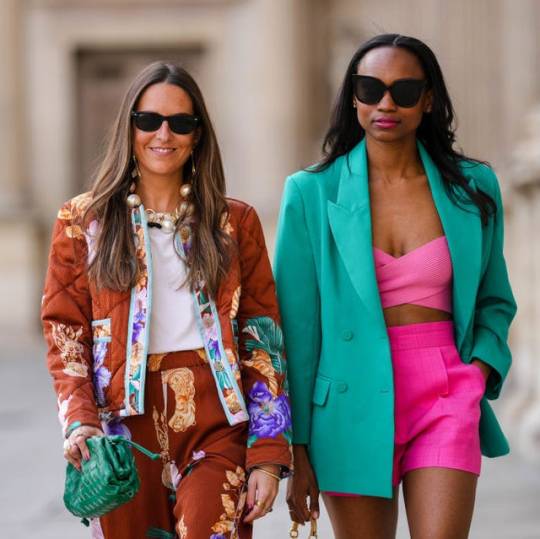
Dopamine Dressing: The Joy of Colour in Fashion
Fashion has always been a medium for self-expression, but sometimes, it takes on a deeper purpose—bringing joy. Dopamine dressing, a trend rooted in wearing vibrant colours and bold patterns to boost mood, has become a sartorial remedy for life’s challenges. This movement invites us to embrace the psychological power of colour and to rethink our wardrobes as tools for emotional well-being.
From neon suiting to kaleidoscopic dresses, dopamine dressing isn’t just a passing trend. It’s a reflection of the human desire to inject joy into everyday life. But what makes it so impactful, and how can you embrace it?
What is Dopamine Dressing?
Dopamine dressing is the idea that wearing certain colours, patterns, and textures can trigger the release of dopamine—a neurotransmitter associated with pleasure and happiness. Scientifically, bright hues like yellow and orange are linked to feelings of warmth and positivity, while shades of blue and green are known to calm and balance the mind.
The psychological effects of colour have been studied for decades. Research by Leatrice Eiseman, executive director of the Pantone Color Institute, suggests that colours directly influence our emotions, making them powerful tools for mood regulation. This explains why a bold pink suit or a sunny yellow dress can feel energising, while neutral tones may feel grounding but less stimulating.
Beyond the science, dopamine dressing taps into the joy of self-expression. It allows individuals to communicate their mood, personality, and even aspirations through what they wear.
Why It Resonates
Dopamine dressing has emerged as a response to challenging times. After periods defined by muted tones and loungewear, many sought to reintroduce excitement and creativity into their wardrobes. Runways embraced this shift, with designers like Valentino championing high-voltage pinks and Christopher John Rogers celebrating maximalism with bold, colourful prints.
Social media played a significant role in popularising dopamine dressing. Platforms like Instagram and TikTok have made colour-blocking and vibrant statement pieces highly visible, with influencers embracing head-to-toe brights or mixing prints with unapologetic flair. Hashtags like #dopaminedressing gained traction, encouraging others to use fashion as a mood booster.
High street retailers also jumped on board, making the trend accessible to wider audiences. Brands like Zara and ASOS offered affordable pieces in neon greens, hot pinks, and tangerine oranges, proving that you don’t need a designer budget to embrace the joy of colour.
How to Embrace Dopamine Dressing
Whether you’re naturally drawn to colour or hesitant to step outside your neutral comfort zone, dopamine dressing is entirely adaptable. Here are practical ways to incorporate it into your style:
Start Small: Experiment with colourful accessories like a vibrant scarf, a pair of statement shoes, or bold jewellery to test how it feels.
Mix and Match: Don’t be afraid to clash prints and textures. Pair stripes with florals or polka dots with plaids for an eclectic, joyful look.
Find Your Palette: Not every bright colour will suit you. Identify shades that flatter your skin tone and resonate with your personal style.
Balance It Out: If head-to-toe brights feel overwhelming, pair statement pieces with neutral basics to keep things grounded.
Fashion as Self-Care
Dopamine dressing isn’t just about aesthetics—it’s a mindset. By choosing outfits that make us feel good, we’re engaging in a small but impactful act of self-care. The right colours and patterns can shift our mood, boost our confidence, and make even the most ordinary days feel a little brighter.
Psychologists often emphasise the importance of small, intentional changes to improve mental well-being, and fashion offers an accessible way to do this. Whether it’s a bold blazer that energises you for a meeting or a whimsical print that sparks joy, clothing can be an emotional reset.
Dopamine dressing reminds us that fashion is more than functional—it’s transformational. It empowers us to embrace colour, take risks, and find joy in self-expression. Whether through a pair of fuchsia trousers or a pastel-patterned coat, this trend invites us to dress not just for how we look but for how we want to feel.
0 notes
Text

The Great Resignation: Why Everyone Is Rethinking Work (and What Comes Next)
A Seismic Shift in the Labour Market
The phrase "Great Resignation" isn't just a catchy headline—it’s a full-blown economic movement. By early 2021, the UK saw record-breaking resignations, with approximately 1 million people handing in their notices in the first quarter alone (ONS). What started as a trickle of burned-out employees quitting en masse quickly turned into a cultural reckoning: What do we actually want from work?
The Decline of Hustle Culture (Finally)
For years, hustle culture was glorified. The “rise and grind” mentality, late-night emails, and the belief that exhaustion equated to success dominated professional spaces. But, by 2021, cracks started to show.
According to a Forbes report, while hustle culture wasn’t exactly dead, it needed a makeover—one that prioritised productivity over performative busyness. The pandemic forced a global pause, and people started questioning why they were sacrificing mental health for KPIs.
The Data Doesn’t Lie: Resignation Rates Tell a Story
Statistics paint a clear picture of this shift. In Q1 2021, job-to-job resignations in the UK hit 994,000, a dramatic increase from pre-pandemic levels (ONS). Meanwhile, job vacancies surged to nearly 900,000, the highest level seen in recent years at that point.
Employees weren’t just leaving jobs; they were redefining career paths altogether. Many pivoted towards freelancing, entrepreneurship, or more meaningful roles with better work-life balance.
Shifting Job Markets and Workplace Priorities
Remote work was the game-changer. Once seen as a perk, it became a standard expectation for many. Surveys from PwC in early 2021 found that 20% of UK workers planned to change jobs within the next year, up from 15% in 2020. Why? Flexibility, purpose, and burnout.
Employees were no longer tolerating toxic work cultures, subpar salaries, or rigid office structures. They wanted careers that fit their lives—not the other way around.
The Death of Capitalism or Just a Midlife Crisis?
The Great Resignation shook the foundations of traditional capitalism. When millions of people start walking away from jobs that prioritise profit over people, it raises an uncomfortable question: Is capitalism in trouble, or just evolving?
An analysis by The Guardian found that Gen Z, in particular, is ditching hustle culture for jobs that offer stability and purpose. Meanwhile, companies are being forced to rethink business models, benefits, and workplace policies—or risk losing talent to competitors who will.
What’s Next?
So, where do we go from here? Are we witnessing a permanent transformation of the workforce, or will the cycle of burnout resurface in a shinier package?
The next few years will likely define whether businesses adapt to this shift or resist it. One thing is certain: employees have tasted autonomy, and there’s no going back to the old normal. If companies want to thrive, they need to stop asking, “How do we get people back in the office?” and start asking, “How do we create work that people actually want to do?”
0 notes
Text
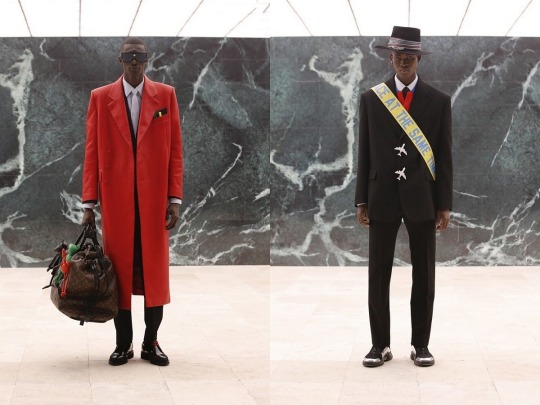
The Genderless Fashion Movement: A Deep Dive into Industry Transformation
The fashion industry has seen a marked increase in gender-neutral collections, driven by shifting societal attitudes and a growing demand for inclusivity. Luxury brands such as Louis Vuitton, Gucci, and Prada have embraced this movement, challenging traditional gender norms and redefining fashion design in the process.

Louis Vuitton’s Spring/Summer 2021 collection featured unisex pieces that emphasized structured tailoring, fluid silhouettes, and neutral palettes. Similarly, Gucci, under Alessandro Michele’s creative direction, has blurred gender lines with androgynous designs—from lace blouses to embroidered suits—establishing itself as a pioneer in gender-fluid fashion. Prada has also integrated unisex elements into its collections, reinforcing the luxury sector’s gradual departure from rigid gender binaries.
This shift is not merely aesthetic but a direct response to evolving consumer preferences. A 2020 Klarna study revealed that nearly 30% of respondents, including an astonishing 50% of Gen Z, had purchased clothing outside their assigned gender category. This signals a significant and growing market for gender-fluid fashion. Major retailers such as H&M, Zara, and ASOS have responded by expanding their gender-neutral offerings, moving beyond the traditional men’s and women’s sections to cater to changing consumer demands.
Gen Z: The Driving Force Behind the Genderless Fashion Movement
Gen Z consumers are rewriting fashion’s rulebook, rejecting outdated gendered clothing categories in favor of self-expression. A 2020 report by UNiDAYS found that:
26% of Gen Z believe that labelling clothing by gender is exclusionary
61% feel the mainstream fashion industry neglects non-binary and transgender individuals
These figures underscore a growing demand for authenticity, representation, and inclusivity in fashion. Unlike previous generations, Gen Z is highly values-driven—aligning their purchasing decisions with ethical considerations such as inclusivity, sustainability, and social responsibility. Their influence has pushed brands to move beyond rigid gendered marketing, favoring fluid, adaptable designs that prioritize comfort and individuality over conformity.
Beyond just product design, Gen Z is reshaping fashion marketing. Social media platforms such as TikTok and Instagram have amplified voices advocating for gender-fluid fashion, normalizing the idea that clothing should be defined by personal style rather than binary categories. Influencers, celebrities, and activists are using their platforms to challenge outdated norms and champion a more inclusive industry, proving that genderless fashion is not just a trend but a cultural shift.

Industry Leaders or Performative Allies? Scrutinising Brand Commitments
While many brands have embraced gender-neutral collections, not all are genuinely committed to the movement. The rise of inclusivity in fashion has also brought about a wave of "rainbow-washing"—where brands capitalize on LGBTQ+ movements and gender inclusivity trends without enacting meaningful change.
Some brands launch limited-edition genderless collections during Pride Month or other cultural moments, only to revert to traditional gender norms in subsequent releases. However, modern consumers are increasingly discerning, supporting brands that back inclusivity with tangible action—such as diverse representation in campaigns, inclusive sizing, and equitable workplace policies—rather than those using inclusivity as a marketing gimmick.
Brands such as Telfar, Collina Strada, and Official Rebrand are setting new industry standards by embedding inclusivity into their hiring practices, collaborations, and long-term business strategies. These labels don’t just offer gender-neutral clothing—they actively challenge the industry’s exclusionary norms and prove that fashion can be both progressive and profitable.
What’s Next? The Future of Genderless Fashion
The momentum behind genderless fashion suggests it is far from a fleeting trend. As societal understanding of gender continues to evolve beyond the binary, the demand for inclusive and diverse fashion will only grow. Brands that authentically embrace this shift—by prioritizing genuine representation, equitable access, and cultural sensitivity—are poised to lead the industry into a more progressive era.
However, brands that treat genderless fashion as a mere marketing tool risk alienating a socially conscious and digitally empowered consumer base. As younger generations continue to shape the future of retail, fashion brands must evolve to reflect the diverse identities of their audience. Genderless fashion is no longer just a stylistic choice—it represents a fundamental shift in how we perceive clothing, identity, and self-expression.
For fashion, this movement is not just about removing labels—it’s about redefining the entire industry.
1 note
·
View note
Text
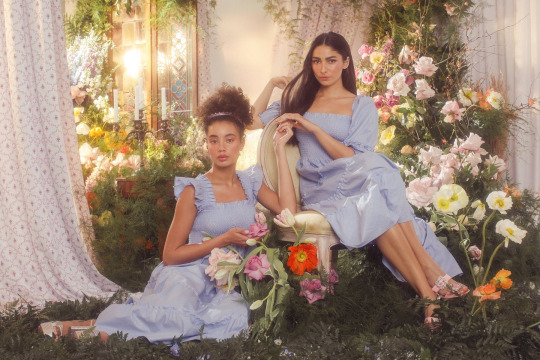
Cottagecore vs. Dark Academia: The Rise of Aesthetic-Driven Fashion
Fashion thrives on reinvention, but sometimes, it just wants to romanticise the past. Enter Cottagecore and Dark Academia, two aesthetics that have taken over wardrobes and social media feeds alike. But are they truly about self-expression or just another form of curated nostalgia?
Cottagecore: Escaping to the Pastoral Dream
Cottagecore is the aesthetic equivalent of running away to the countryside to bake bread, tend to a garden, and write poetry by candlelight. It's all flowing prairie dresses, lace blouses, and cosy knitwear, often in muted, nature-inspired hues. But beyond the fashion, it’s a lifestyle fantasy—one that hinges on self-sufficiency, slow living, and a rejection of modern chaos.
The movement gained traction during lockdowns, when the idea of escaping the digital grind in favour of baking sourdough and hand-sewing linen dresses felt almost radical. The rise of Cottagecore coincided with a cultural shift towards sustainability and ethical consumption, making it more than just an aesthetic—it became a statement against fast fashion, mass production, and burnout culture.
Yet, paradoxically, the fashion industry was quick to commodify it. Brands churned out “peasant dresses” at breakneck speed, often produced under the same exploitative systems that Cottagecore supposedly rejects. The question remains: is it truly an alternative to mainstream fashion, or just a softer, earth-toned version of it?
Dark Academia: A Sartorial Love Letter to Intellectualism
If Cottagecore is about pastoral bliss, Dark Academia is about scholarly mystique. It’s brooding libraries, well-worn books, and tweed blazers worn with an air of existential angst. Rooted in a love for classical literature, Gothic architecture, and old-world academia, this aesthetic caters to those who romanticise intellectual pursuits—whether or not they’ve ever set foot in an Ivy League library.

ALT
Fashion-wise, Dark Academia leans into structured tailoring, vintage-inspired layering, and a moody, autumnal palette. Think: wool coats, turtlenecks, and loafers—essentially, the unofficial uniform of brooding literary protagonists.
Much like Cottagecore, Dark Academia took off in response to a growing dissatisfaction with hyper-digitised culture. As education moved online, many craved the tangible experience of ink-stained notebooks, heavy textbooks, and quiet study sessions in dimly lit cafés. But while it celebrates knowledge, it also veers into elitism—its visual cues are often associated with Western, Eurocentric institutions, excluding other cultural interpretations of academic excellence.
More Than Just Aesthetics? The Psychological and Cultural Appeal
Why are these aesthetics so popular? Simple: they offer a curated escape from modern life.
Cottagecore satisfies the desire to unplug and return to a simpler, slower existence, even if only through fashion.
Dark Academia provides structure and purpose in an era of information overload, where knowledge itself feels like a form of rebellion.
Both aesthetics serve as a reaction to digital fatigue, offering something tactile, whether that’s a hand-knitted cardigan or the weight of a well-worn book. They also reflect broader anxieties about identity and belonging in a world where personal style is increasingly shaped by algorithms rather than lived experience.
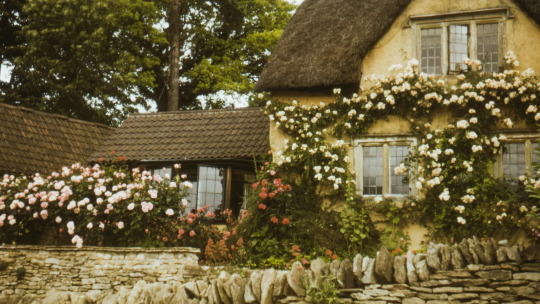
ALT
But as they become more mainstream, the irony deepens. When an aesthetic that champions anti-consumerist values becomes mass-produced, does it lose its soul?
Self-Expression or Aesthetic Uniform?
For movements that claim to champion individuality, both Cottagecore and Dark Academia have remarkably strict visual codes. Cottagecore expects soft florals, vintage lace, and an ethereal softness. Dark Academia demands dark wool coats, old books, and a touch of melancholic introspection.
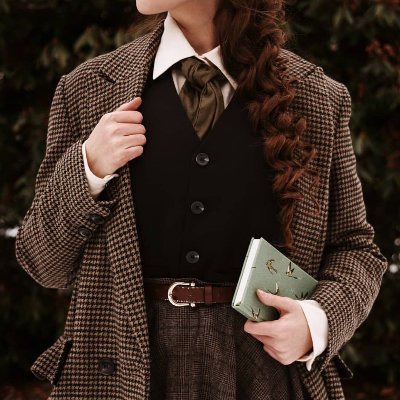
ALT
While they encourage nostalgia-driven self-expression, they also risk turning into aesthetic checklists. The line between personal style and aesthetic conformity is increasingly blurred—if everyone is dressing the same way, is it still about self-expression?
What’s Next? The Future of Nostalgia Dressing
The cyclical nature of fashion means Cottagecore and Dark Academia won’t stay static. Expect hybrid aesthetics—think Cottagecore-meets-Goth (cottage-goth) or a more futuristic, tech-infused academia. Meanwhile, the rise of AI and digital fashion could challenge their appeal, as handmade and physical elements become even more niche.
But the real question isn’t whether these trends will evolve—it’s whether they will remain meaningful or just another passing aesthetic phase. Will the next generation romanticise something new, or are we forever trapped in fashion’s nostalgia loop?
Whatever happens, one thing is certain: we’ll always find ways to dress our longing for the past in new clothes.
0 notes
Text
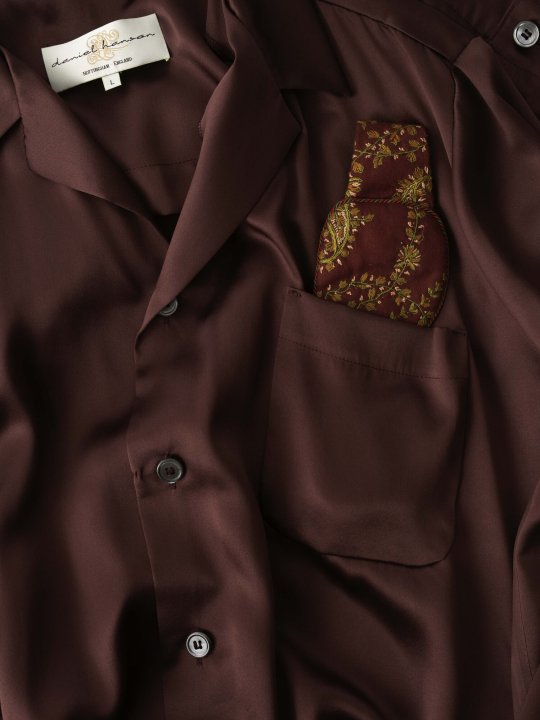
From Couch to Catwalk: How Lockdown Elevated Loungewear to Luxury Status
Once upon a time, loungewear was the uniform of lazy Sundays and emergency dashes to the corner shop—cosy, practical, but hardly aspirational. Then, lockdown hit, and suddenly, cashmere joggers and silk pyjamas weren’t just wardrobe staples—they were status symbols.
What began as a pandemic necessity quickly transformed into a lasting fashion movement. But why does this trend still resonate today, and how has it shaped the way we dress post-lockdown?
The Surge in Loungewear Sales
When the world hit pause, fashion took a sharp turn towards comfort. The shift wasn’t just anecdotal—it was financial. In the UK, loungewear sales skyrocketed by 1,303% in 2020 as repeated lockdowns kept people indoors and traditional workwear became obsolete.
This wasn’t a fleeting moment. The global sleepwear and loungewear market is on track to reach $22.3 billion by 2030, growing at a CAGR of 8.7%, fuelled by an ongoing preference for relaxed dressing and the explosive growth of online shopping.
Even as restrictions lifted, the appetite for comfortable, polished pieces didn’t wane. Instead, it evolved, prompting high-fashion brands to take note.
Luxury Brands Embrace the Trend
The rise of loungewear wasn’t just about practicality—it became a statement of effortless luxury. Recognising this shift, high-end fashion houses traded their sharp tailoring for softer, more relaxed silhouettes.
Dior responded with ‘Chez Moi’, its first-ever dedicated loungewear capsule. Featuring pyjama sets, kimonos, and bathrobes, the collection celebrated the art of living at home—elegantly.
Once a niche silk pyjama brand, Olivia von Halle became a cult favourite as luxury shoppers embraced the idea of "bed-to-brunch" dressing, blurring the line between sleepwear and streetwear.
This wasn’t just about staying comfortable—it was about redefining what luxury looked like. No longer confined to evening gowns and structured tailoring, high-end fashion found a new muse in the understated ease of loungewear.
The Psychology of Comfort Dressing
What started as a necessity soon became a cultural shift. The blurred boundaries between work and home forced a collective rethink of what it meant to “get dressed.”
But was this just a temporary pandemic reaction? Not quite.
The rise of "quiet luxury"—understated, timeless fashion—suggests that comfort-driven dressing isn’t just a passing phase; it’s a lifestyle choice. Consumers are stepping away from loud, logo-heavy pieces in favour of high-quality, long-lasting garments that seamlessly blend comfort with sophistication.
The shift reflects a broader societal change: dressing well is no longer about external validation but about personal ease and investment in longevity. Luxe loungewear isn’t just about how it looks—it’s about how it feels.
Is Structured Fashion Dead?
Not entirely. While loungewear has cemented its place in the modern wardrobe, structured fashion isn’t disappearing—it’s evolving.
Today’s consumers prioritise versatility, seeking garments that transition effortlessly between casual and formal settings. Traditional tailoring has softened—literally. Blazers are now oversized and relaxed, suits are cut from lighter, stretch-infused fabrics, and the very concept of "dressing up" has shifted from rigid formality to effortless polish.
Rather than a battle between comfort and structure, fashion is merging the two. It’s not about choosing between a silk robe or a power suit—it’s about finding pieces that balance the best of both.
What’s Next?
Loungewear may have redefined luxury, but fashion is nothing if not cyclical. As trends continue to evolve, the future lies in hybrid dressing—a fusion of comfort and polish that aligns with today’s fluid, work-from-anywhere lifestyle.
Luxury brands may have pivoted to pyjamas, but as history proves, reinvention is the true constant in fashion. The real question is: What’s the next status symbol?
Silk slippers for the boardroom? Knitted suits? Only time (and TikTok) will tell.
0 notes